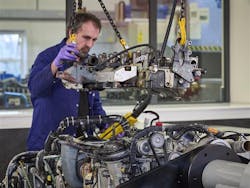Lubrizol's Lab-to-Market Strategy Takes Flight: Testing Batch to Continuous Processing
At Lubrizol Corp.’s research and development hub near Cleveland, raw materials flow through a series of vessel containers and metering pumps before reaching six reactors situated on a modular platform the size of a shipping container.
Engineers at the pilot plant, located at the company’s headquarters in Wickliffe, Ohio, are testing more efficient ways to produce a decades-old technology experiencing increased demand for sustainable aviation fuel (SAF) applications.
Lubrizol's global headquarters occupies 90 acres in this suburb about 15 miles east of Cleveland. The site includes two separate campuses, with an east complex that houses the corporate services offices and a west campus that includes R&D testing facility and a pilot plant.
One of the products being tested here at the pilot plant, called SulfrZol 54, is a catalyst sulfiding agent used in refining hydrotreating processes to remove impurities from fuels.
While SulfrZol 54 dates back to 1997, it has seen renewed demand as the SAF market grows. This spike prompted the company to seek more efficient production methods, including the possibility of moving from batch to continuous manufacturing, said Nico Proust, chemical process innovation manager at Lubrizol.
The product is typically produced in 50,000-gallon batch reactors. Facing the need for additional capacity, the company identified three options: duplicating its existing batch process, outsourcing to a supplier or developing new technology to increase capacity at lower cost.
Engineers identified continuous processing as a way to minimize production costs without investing in a large batch reactor while keeping the manufacturing process in house. Lubrizol looked internally for solutions — a strategy the company employs across the entire organization. As Greg McCullough, site manager at the pilot plant, explained during a tour of the facility, the company is fully integrated from chemistry design to production.
This internal focus on building capabilities represents a potential competitive advantage compared with other chemical producers that may rely on third parties for support (see sidebar). By taking on the expansion project in house, the company can minimize toll manufacturing and transportation fees and protect its intellectual property, Proust said.
Systematic Evaluation Process Drives Innovation
Lubrizol employed an internal collaboration process to move forward on the project using its Most Effective Technology (MET) program. The program involves a cross-functional group of engineers and chemists who meet regularly to evaluate the existing state of performance and future technologies.
“Scientists and engineers are some of the least creative people, so we came up with this process,” joked Connor Twomey, global director, process technology.
The process is based on three performance levels – “base,” or the existing state; “plus,” which maximizes today's available technology; and “prime, “which reimagines the future.
At the “base” stage, for example, the team might have multiple locations that make the same products. The team will evaluate its plants worldwide that are making those products—some of which may use slightly different raw materials because of their geographic location or have different processes for manufacturing—and assess based on various criteria like cycle time and waste generated which unit has the most effective technology, Proust said.
"We want to make sure that if we have one unit that is clearly less efficient than the other ones, we modernize that asset," he said.
Twomey, who runs the program, builds dashboards to help in the evaluation process so the organization can understand where it stands regarding how harmonized operations are companywide and which areas need improvement.
In some cases, even the top-performing unit may demonstrate areas of waste or inefficiencies. This is where the “plus” process comes in. The MET team may conduct further analysis to understand how to make operations more energy efficient or sustainable, for example.
The “prime” stage looks at revamping the process completely. This involves a much larger capital investment and longer timeframe.
“We’re talking about multimillion dollars, potentially, to deploy new units,” Proust said.
The plan to move from batch to continuous production on SulfrZol 54 was part of that “prime” decision-making process. Central to this collaborative process is the back and forth between scientists and engineers.
The earlier-stage MET evaluations are typically focused on equipment improvements, which requires engineering expertise. But as the team moves on to the prime stage, they’re looking at revamping technologies, and that’s where collaboration between engineering and the chemists becomes critical, Proust said.
“If we’re studying the reaction kinetics and temperature effect on an outcome, the chemists need to be heavily involved (to ensure they’re still making the same molecule),” Proust said. “But in order to study that, we also need to leverage the tubular reactors and electrify heat exchangers, different dynamic mixing systems where the engineers are the ones who are inputting that information.”
Modular Design Enables Flexible Manufacturing
Continuous reactors have a smaller footprint and are more efficient in terms of heat and mass transfer, Proust said. In addition, continuous processes eliminate downtime that occurs during batch transfers and equipment clean-up. This enables the use of smaller equipment, which minimizes footprint requirements, as Chemical Processing contributor John Dever explained in his article, “Batch vs. Continuous: When to Make the Switch.”
“If you have a 1,000-gallon reactor and you're running a batch process, you fill it up, you cook it, you empty it, you move on to the next one,” Proust explained. “You will process less material over a period of time than if you're continuously pumping through the same 1,000 gallon-reactor.”
Batch reactors also have comparably poor mixing capabilities because the impeller is small in relation to the batch size. The process also involves the use of jacketed vessels, which means the heat must penetrate all the way through the batch from the outside.
By moving to smaller tubular reactors, heating or cooling can penetrate more quickly. They also employ inline mixing capabilities, which provides greater mixing efficiency, according to Proust.
The modularity of Lubrizol’s continuous processing setup provides additional advantages. The engineering team built the reactors on skids to more easily plug in new reactor technology and replace or eliminate raw materials.
“It’s a manufacturing unit that is kind of plug-and-play,” Proust said. It’s able to produce what a full-size unit would do on the order of thousands of metric tons per year.”
It’s also safer because the modular unit reduces the amount of chemicals that are exposed to reactive conditions, Proust said.
Currently, Lubrizol’s process innovation team has about six different batch-to-continuous projects in the works, with three at the pilot stage, including one involving its PemuPur Vista polymeric emulsifier used in skin-care products. The others are undergoing testing and analysis at the R&D center’s large-volume lab to determine whether they’re suitable for scale-up based on two key factors.
“We need to make sure that we have growing demand for a product that we don't have capacity for or we're trying to internalize a product that is really expensive to make in a third-party location,” Proust said.
Once the team validates the opportunity, they must test the chemistry to make sure it’s compatible with the continuous process.
The company expects the SulfrZol 54 pilot project to wrap up by the end of the year, said
Nasser Al Azri, a process innovation engineer at the plant. After that, the company will identify a site, which involves evaluating available utilities and infrastructure. The anticipated timeline for full-scale production is mid-2027, with a production target of 5,000 metric tons per skid.




